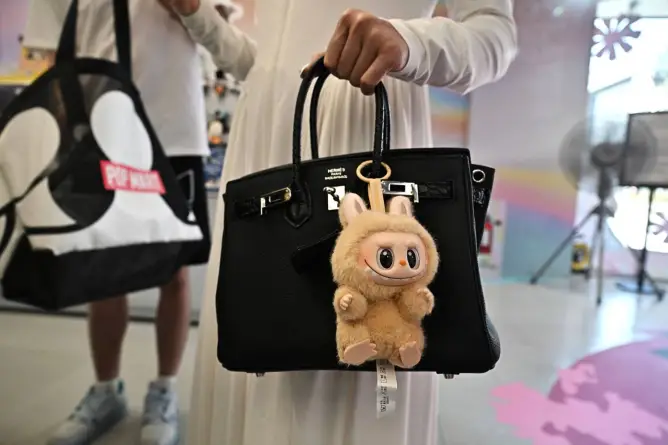If you thought Apple’s $19 polishing cloth was the ultimate flex of luxury-minimalist bafflement, the company’s newest accessory might push you past incredulity into full-on fascination. Meet the iPhone Pocket: a sock-like, one-piece cloth sling for your phone, crafted in two sizes — a short version priced at $149.95 and a long, crossbody iteration at $229.95. At first glance, it is the sort of product designed to spark hot takes and Twitter threads. Look a little closer, though, and the Pocket starts to make a curious kind of sense.
Apple’s description leans into a fashion-world vocabulary: the design is “inspired by the concept of ‘a piece of cloth,’” a single fabric that comprises the whole object. That phrasing is not empty branding. It calls back to a specific lineage in contemporary design — most notably the APOC (A Piece Of Cloth) philosophy pioneered by Issey Miyake in the 1990s. Miyake’s approach emphasized innovation in textiles, pleating techniques that allowed garments to morph with the body, and a minimal waste ethos. It’s not hard to imagine why Apple, a company obsessed with materiality and reductive forms, would pick up the aesthetic baton.
There’s also a personal link between Miyake and Apple’s mythology. The late designer’s spare black mockneck is as much a part of the Steve Jobs image as the logo on a MacBook. Jobs and Miyake shared an appreciation for uniforms and clean silhouettes; Jobs even enlisted Miyake to design a sort of personal uniform in the 1990s. Whether Apple’s iPhone Pocket is a direct descendant of that relationship or an homage is less important than the cultural continuity it reveals: this is an object that sits at the cross-section of tech, fashion, and identity.

But does that elevate a sock-like iPhone carrier into a designer must-have? For fashion people, the answer is often yes. Accessories are a way of signaling taste and taste-making. A small, brightly colored pocket slung from a bag or worn as a pendant can work as a covetable accent the way a rare enamel pin or an unexpected bag charm does. The short Pocket — offered in a wider range of colors and priced lower than the crossbody — looks aimed at precisely that impulse: buy a pop-of-color sock to clip, tie, or drape on something you already own. In that respect, Apple’s product strategy echoes the micro-trends that have dominated the past few years: miniature bags, collectible keychains, and branded tchotchkes that act as accessories for other accessories.
That’s where the comparison to Labubu, the plush monster keychain collectible that achieved a near-fetish status, makes sense. A Labubu blind box might cost around $30, but certain rare variants fetched thousands on resale markets. The more absurd aspect of that craze wasn’t just that people wanted tiny stuffed monsters; it was that they wanted them as status objects for their bags and phones. The iPhone Pocket seems to tap into the same cultural current: the elevation of miniature, seemingly frivolous objects into markers of personal style and social meaning.
Practicality, though, can’t be ignored. Apple’s Pocket isn’t purely decorative. The ribbed mesh structure, which recalls Miyake’s pleats, is designed to stretch, reveal, and let you peek at your phone screen. In a world where Tap to Pay and digital wallets make it increasingly possible to leave your house with only a phone, portable phone carriers — and the bags designed to hold phones rather than the other way around — are an answer to a real-lifestyle shift. The Pocket can protect a device, offer hands-free convenience, and enable quick access without the bulk of a traditional bag. In the long crossbody form, it joins an expanding category of phone-first accessories, alongside Apple’s own $59 crossbody strap and a host of camera- and phone-friendly straps from other brands.
Still, the sticker shock is part of the conversation, and it’s hard to ignore. At $149.95 for a short sock for your phone, and $229.95 for a crossbody that comes in just three colors, the Pocket sits in a rarefied price bracket. It asks consumers to pay for design pedigree, material refinement, and perhaps a slice of cultural capital. Critics will see this as emblematic of luxury’s ability to repackage the mundane; fans will point to craftsmanship, the Miyake-inspired textile, and the pleasure of owning an object that intentionally mediates between tech and fashion.
There’s also a sustainability angle worth considering. Miyake’s APOC philosophy was, in part, a response to waste-heavy fashion cycles. Single-piece constructions and transformable garments can reduce cutting and seam waste. If the iPhone Pocket is made to last and to be used rather than discarded, it aligns with a more conscientious approach to accessories. But longevity often collides with the very impulses that make these objects trendy: collectability, color releases, and seasonal drops. The question becomes whether the Pocket will be a durable addition to one’s daily carry or a fleeting piece of holiday hype.
Culturally, the Pocket is a window into how we think about value and identity in 2025. We live in a world where small, curated signals — a colorway, a logo, the right collaboration — communicate belonging and taste. Tech companies now design products with fashion logic in mind, and fashion brands borrow tech’s functionality. The iPhone Pocket is a briefcase of those ideas stuffed into a tiny tube of fabric.
Will it become the Labubu of 2026? Maybe. Fads are hard to predict, and sometimes the least sensible objects find their way into mainstream affection precisely because they feel a bit ridiculous. The more sober possibility is that the Pocket will find a steady audience among people who care about materiality, who like the idea of a single-piece textile that hovers between protection and adornment, and who are willing to pay a premium for that blend of form and function.
If nothing else, Apple’s iPhone Pocket continues a longer conversation about our devices and our bodies. Phones are increasingly extensions of us — wallets, keys, cameras — and the accessories we build around them tell stories about how we move through the world. A $229 crossbody sock might seem like the punchline of luxury minimalism, or it might be the future of bite-sized personal gear. Either way, it has already done what good design often does: made us talk, laugh, and reconsider why we buy what we buy.
Call it a capsule of our moment, in cloth form. Whether you scoff, covet, or quietly add one to your cart, the iPhone Pocket proves that even in a hyperrational tech ecosystem, there’s still room for whimsy — and for a little bit of sartorial theater.

















暂无评论内容